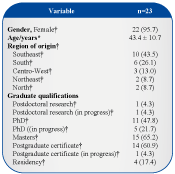Scale for measurement of healthcare-associated infection risk in adult patients: development and content validation
DOI:
https://doi.org/10.15649/cuidarte.v10i2.771Palabras clave:
Risk Assessment, Validation Studies, Infection Control, Patient SafetyResumen
Introduction: Hospital settings involve several risk factors related to healthcare-associated infections (HAIs). A method that contributes to prevention and control is identification of risks to enable implementation of preventative measures. It is believed that this identification can be accomplished using scales. The present study attempts to develop and validate the face and content of a new scale for measuring HAIs risk in hospitalized adults. Materials and Methods: A methodological study conducted to develop and validate the face and content of the Adult Inpatients Infection Risk Assessment scale, which underwent evaluation by a committee of 23 experts with experience in HAIs. The scale’s validity was tested using the Content Validity Index (CVI). Results: 15 items were retained in the scale, grouped into two dimensions: intrinsic and extrinsic factors. Certain minor adjustments were needed to improve the clarity of some items. Items’ CVIs ranged from 0.83 to 1.0 and the scale’s mean CVI was 0.90. Discussion: The Adult Inpatients Infection Risk Assessment scale can be used as a technology of low cost for the measurement of the risk of infection, which allows the planning of more accurate and organized interventions of the health team targeting at preventive and safe care during hospitalization. Conclusions: The findings supported the face and content validity of the Adult Inpatients Infection Risk Assessment Scale.
How to cite this article: Rodríguez-Acelas AL, Cañon-Montañez W, Almeida MA. Scale for measurement of healthcare-associated infection risk in adult patients: development and content validation. Rev Cuid. 2019; 10(2): e771. http://dx.doi.org/10.15649/cuidarte.v10i2.771
Referencias
Allegranzi B, Bagheri-Nejad S, Combescure C, Graafmans W, Attar H, Donaldson L, et al. Burden of endemic health-care-associated infection in developing countries: systematic review and meta-analysis. Lancet. 2011; 377 (9761): 228-41. http://dx.doi.org/10.1016/S0140-6736(10)61458-4
Centers for Disease Control and Prevention. National and State Healthcare-Associated Infections progress report. 2016. [online] available: http://www.cdc.gov/HAI/pdfs/progress-report/hai-progress-report.pdf
Bammigatti C, Doradla S, Belgode HN, Kumar H, Swaminathan RP. Healthcare Associated Infections in a Resource Limited Setting. J. Clin Diagn Res. 2017;11(1):OC01-OC04. http://dx.doi.org/ 10.7860/JCDR/2017/23076.9150
Pereira FG, Chagas AN, Freitas MM, Barros LM, Caetano JA. Caracterização das infecções relacionadas à assistência à saúde em uma Unidade de Terapia Intensiva. Vigil. sanit. debate. 2016;4 (1): 70-7. http://dx.doi.org/10.3395/2317-269x.00614
Mehta Y, Gupta A, Todi S, Myatra S, Samaddar DP, Patil V, et al. Guidelines for prevention of hospital acquired infections. Indian J Crit Care Med. 2014;18 (3): 149-63. http://dx.doi.org/10.4103/0972-5229.128705
Centers for Disease Control and Prevention. Guideline for isolation precautions: Preventing transmission of infectious agents in healthcare settings. 2014. [online] available: http://www.cdc.gov/hicpac/pdf/isolation/Isolation2007.pdf
Bergstrom N, Braden BJ, Laguzza A, Holman V. The Braden scale for predicting pressure sore risk. Nursing Research. 1987;36(4):205-210.
Coluci MZ, Alexandre NM, Milani D. Construction of measurement instruments in the area of health. Cien Saude Colet. 2015;20(3):925-36. http://dx.doi.org/10.1590/1413-81232015203.04332013
Keszei A, Novak M, Streiner DL. Introduction to health measurement scales. J Psychosom Res. 2010;68 (4):319-23. http://dx.doi.org/ 10.1016/j.jpsychores.2010.01.006
Junior CN, Padoveze MC, Lacerda RA. Governmental surveillance system of healthcare-associated infection in Brazil. Rev Esc Enferm USP. 2014;48 (4):657-62. http://dx.doi.org/10.1590/S0080-623420140000400012
European Centre for Disease Prevention and Control. Healthcare Associated Infection (HAI), 2017. [online] available: http://ecdc.europa.eu/en/healthtopics/Healthcare-associated_infections/Pages/index.aspx#sthash.bdrTWt7C.dpuf
Joint Comission on Acreditation of Healthcare Organization. List of Joint Commission approved subjects for screening indicators for hospital. 2006. [online] available: http://www.jointcomission.org
Menegueti MG, Canini SR, Bellissimo-Rodrigues F, Laus AM. Evaluation of Nosocomial Infection Control Programs in health services. Rev Lat Am Enfermagem. 2015;23 (1): 98-105. http://dx.doi.org/ 10.1590/0104-1169.0113.2530
Borghardt AT, Prado TN, Araújo TM, Rogenski NM, Bringuente ME. Evaluation of the pressure ulcers risk scales with critically ill patients: a prospective cohort study. Rev Lat Am Enfermagem. 2015; 23 (1):28-35. http://dx.doi.org/ 10.1590/0104-1169.0144.2521
Díaz-Heredia LP, Muñoz-Sánchez AI, de Vargas D. Reliability and validity of spirituality questionnaire by Parsian and Dunning in the Spanish version. Rev Lat Am Enfermagem. 2012;20(3):559-66. http://dx.doi.org/10.1590/S0104-11692012000300018
Fernandes MG, Costa KN, Santos SR, Pereira MA, Oliveira DS, Brito SS. Risco para úlcera por pressão em idosos hospitalizados: aplicação da Escala de Waterlow. Rev Enferm UERJ. 2012;20 (1):56-60.
Almeida CM, Rodrigues VM, Escola JJ. The representations of human vulnerability held by health workers – development and validation of a scale. Rev Lat Am Enfermagem. 2013; 21 (Spec):29-37. http://dx.doi.org/10.1590/S0104-11692013000700005
Pasquali L. Psychometrics. Rev. esc. enferm. USP. 2009;43 (spe): 992-9. http://dx.doi.org/10.1590/S0080-62342009000500002
Streiner DL, Norman GR. Health measurement scales. A practical guide to their development and use. 4th ed. Oxford University Press, New York, 2008.
Wynd CA, Schmidt B, Schaefer MA. Two quantitative approaches for estimating content validity. West J Nurs Res. 2003;25(5):508-18. https://doi.org/10.1177%2F0193945903252998
Lunne M, McGuire M, Endozo N, McIntosh-Waddy D. Consensus-validation study identifies relevant nursing diagnoses, nursing interventions, and health outcomes for people with traumatic brain injuries. Rehabil Nurs. 2010;35 (4):161-66. https://doi.org/10.1002/j.2048-7940.2010.tb00042.x
Lynn MR. Determination and quantification of content validity. Nurs Res. 1986;35 (6): 382-6.
Polit DF, Beck CT. The content validity index: are you sure you know what’s being reported? Critique and recommendations. Res Nurs Health. 2006;29 (5): 489-97.
Rodríguez-Acelas AL, Almeida MDA, Engelman B, Cañon-Montañez W. Risk factors for healthcare-associated infection in hospitalized adults: Systematic review and meta-analysis. Am J Infect Control. 2017;45(12):e149-e156. http://dx.doi.org/10.1016/j.ajic.2017.08.016
Guzmán-Herrador B, Molina CD, Allam MF, Navajas RF. Independent risk factors associated with hospital-acquired pneumonia in an adult ICU: 4-year prospective cohort study in a university reference hospital. J Public Health (Oxf). 2016;38 (2):378-83. http://dx.doi.org/ 10.1093/pubmed/fdv042
Lopes MV, Silva VM, Araujo TL. Métodos de pesquisa para validação clínica de conceitos diagnósticos Inc: Herdman TH; Carvalho, EC (org) PRONANDA: Programa de Atualização em Diagnósticos de Enfermagem: conceitos básicos. Artmed/Panamericana. Porto Alegre, 2013.
Grant JS, Davis LL. Selection and use of content experts for instrument development. Rev Nurs Health. 1997;20 (3):269-74.
Polit DF, Beck C, Owen S. Is the CVI an acceptable indicator of content validity: appraisal and recommendations. Res Nurs Health. 2007;30 (4): 459-67.
Amendola F, Alvarenga MR, Gaspar JC, Yamashita CH, Oliveira MA. Validade aparente de um índice de vulnerabilidade das famílias e incapacidade e dependência. Rev Esc Enferm USP. 2011; 45 (spe2):1736-42. http://dx.doi.org/10.1590/S0080-62342011000800017
Couto RC, Pedrosa TM, Cunha AF, Amaral DB. Infecção hospitalar e outras complicações: Epidemiologia, controle e tratamento. 4th ed. Guanabara, São Paulo, 2009.
Rodríguez-Acelas AL, Cañon-Montañez W. Contribuciones de las escalas en salud como herramientas que influencian decisiones en el cuidado de los pacientes. Rev Cuid. 2018; 9(1): 1949-60. http://dx.doi.org/10.15649/cuidarte.v9i1.498

Descargas
Publicado
Cómo citar
Número
Sección
Altmetrics
Descargas
Licencia
Journal Cuidarte, scientific publication of open access, is licensed under a Creative Commons Attribution (CC BY-NC), which permits use, distribution and reproduction in any medium, provided the original work is properly cited and is not used for commercial purposes.
Any other form of use such as reproduction, transformation, public communication or distribution, for profit, requires the prior authorization of the University of Santander UDES.
The names and e-mail addresses entered in the Journal Cuidarte will be used exclusively for the purposes stated by this magazine and will not be available for any other purpose or other person.
The articles published in the Journal Cuidarte represent the criteria of their authors and do not necessarily constitute the official opinion of the University of Santander UDES.







